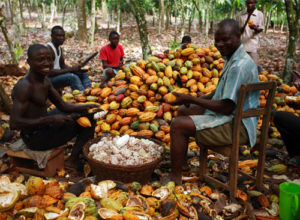
Demand for the farmers' crops keep increasing. Yet supply remains low. Prices of crops in urban areas have gone up. Yet farmers in the rural part have very little income to show for it.
This plight of the smallholder farmer, which is evident from the fact that even though what they grow is the backbone of the country’s economy, they earn an income which is mostly less than the salary of people with white-collar jobs.
Because of this low income, smallholder farmers have little or no access to good health care, education, safe drinking water, and other basic services.
Simply put, the smallholder farmer is going through certain challenges and needs support.
"In certain parts of the country, the farmer has poor returns. And most of the farmers in such areas are debt-ridden." Schandorf Adu Bright, Director of Farmer Services at Farmerline, says. "If stakeholders don't come up with a sustained incentive structure for the farmers, we could slip back to the period of food shortages."
So to unlock income opportunities for smallholder farmers, it is important that farmers are given adequate support.
For Worlali Senyo, Director of Growth, Research and Development at Farmerline, there needs to be a promotion of good agricultural practices amongst farmers to realise this. "Good farming practices will not only help smallholder farmers increase their income but also grow healthier crops for buyers, consumers and their immediate families," Worlali said. "In this light, farmers need to be taught how to rotate crops, how to monitor and manage pests while avoiding the use of chemicals and how to use recommended farm inputs like quality seeds, fertilizer and agro-chemicals. This will generate additional yield which will help them earn more money."
For Patrick Sakyi, Monitoring and Evaluation Associate at Farmerline, farmers need to be connected to markets that do not rip them off. "Farmers need the right information about different markets to be able to access and relate to them. When they find such reliable and profitable markets where they can sell their produce, they will earn a fair wage, which will be more than what they were previously earning."
Schandorf Adu Bright also adds that an embracing simple technologies that allow medium to long-term storage should be encouraged. "Post-harvest losses are extremely high due to a lack in adequate storage facilities. As a result, smallholder farmers have little wiggle room and are forced to sell their produce soon after harvesting when the price is at its lowest," Schandorf says. "Having adequate storage facilities will mean there is longer preservation of crops, which will create a flexibility for farmers on the best time to sell their produce. This will ensure that farmers get a good price for most of their produce and make twice what they make already," he adds.
When farmers make more income from the sale of their produce, there's more development in the rural areas which ultimately impacts positively on the overall economy.
This news item is part of a Partner Spotlight on Farmerline (4-11 November). Each week, the GFAR Secretariat is turning the spotlight on the work and collective actions of Partners in GFAR who share in our mission to strengthen and transform agri-food research and innovation systems globally. For more information on the Partners in GFAR, and to become a Partner, click here!
